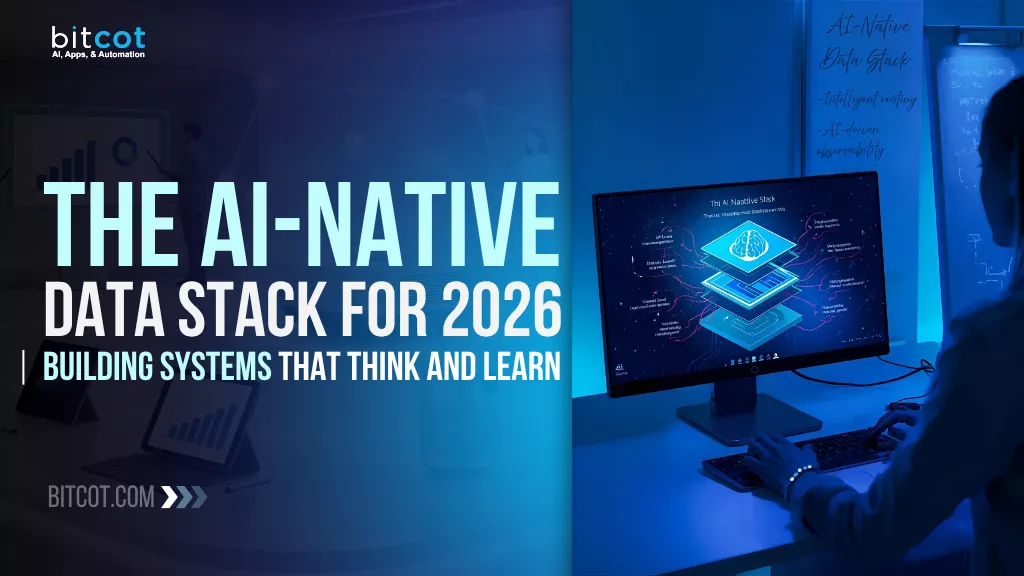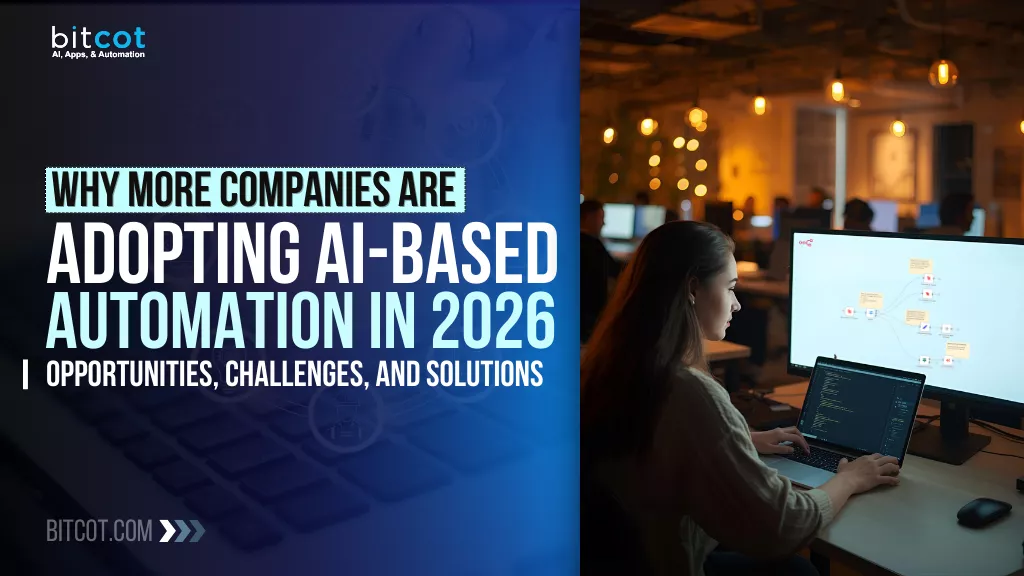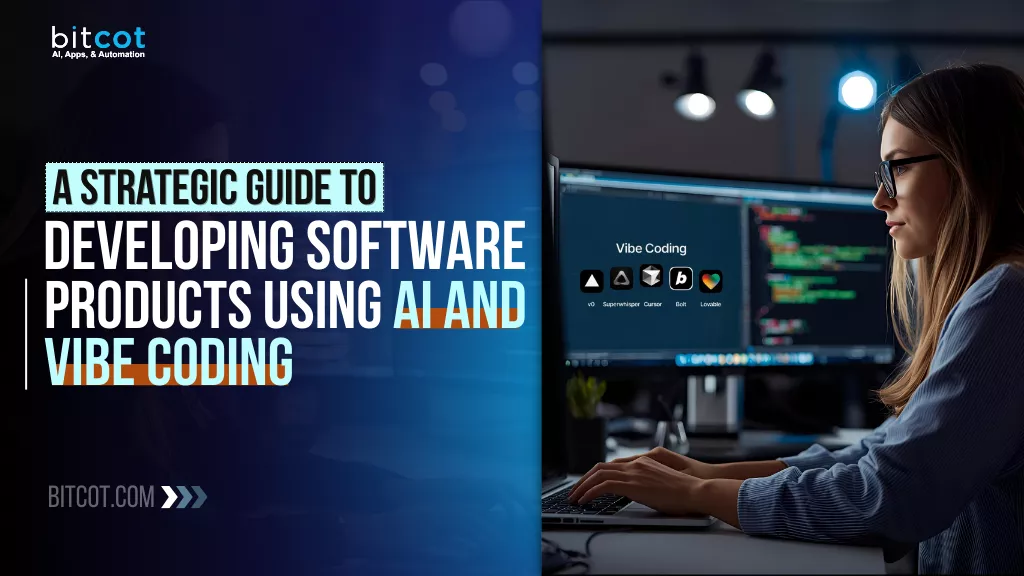
Your data flows through every system, dashboard, and tool: CRMs, analytics platforms, data warehouses, and AI apps, all trying to make sense of what’s happening in your business.
But if your data stack wasn’t built for intelligence, every insight starts from zero. Teams waste time cleaning and moving data instead of using it. Pipelines break when schemas shift. Dashboards lag behind decisions.
Sound familiar?
Today’s world runs on real-time intelligence, not nightly batch jobs. Data isn’t just collected; it’s interpreted, connected, and acted upon instantly. When your architecture can’t keep up, opportunities slip away.
In this post, we’ll walk through what it takes to build an AI-native data stack for 2026, a system that doesn’t just store information but thinks and learns from it. You’ll see how modern organizations are rebuilding their data foundations with:
- Continuous intelligence instead of traditional ETL
- Vector databases that enable semantic understanding
- AI orchestration layers that automate discovery, access, and optimization
Ask yourself:
- How many of your pipelines still rely on manual scripts?
- How much context is lost between your data and your decisions?
- You already know the pain points, but are your systems evolving fast enough to handle what’s next?
Whether you’re a data leader, engineer, or architect, the shift is here. The smartest companies are moving beyond dashboards to living, adaptive data ecosystems powered by AI agents and vector intelligence.
At Bitcot, we help teams make that transition, designing intelligent data systems that learn, optimize, and scale with your organization.
The future of data isn’t built on code alone. It’s built on cognition. Are you ready to build systems that think?
What is an AI-Native Data Stack?
An AI-native data stack is more than a modernized version of your existing infrastructure; it’s a complete rethinking of how data moves, learns, and adapts across your organization.
In traditional stacks, data flows linearly: extract, transform, load, visualize. Intelligence is added later through dashboards, reports, or isolated machine learning models.
But in an AI-native world, intelligence is baked in from the start. Every layer, ingestion, processing, storage, and access, is infused with AI capabilities that continuously interpret, optimize, and evolve your data ecosystem.
Instead of static rules and rigid schemas, you get self-optimizing systems that understand meaning and context:
- Semantic extraction, where AI parses unstructured data, such as text, images, and audio, without predefined rules.
- Intelligent routing that directs data based on what it is, not just where it came from.
- Adaptive transformations that learn from user patterns and continuously improve data quality.
- AI-driven observability that detects anomalies before humans even notice.
In short, an AI-native data stack doesn’t just power your analytics; it becomes part of your decision-making fabric. It’s what turns raw data into living intelligence.
This is the foundation of every forward-thinking organization in 2026: systems that don’t just process information, but understand and act on it, automatically.
Why Modern Data Stack Solutions Matter in 2026
In 2026, modern data stack solutions are no longer just a nice-to-have; they’re the foundation of how competitive organizations operate.
The traditional approach of siloed tools, static reports, and nightly data refreshes can’t keep pace with today’s real-time, AI-driven business environment.
A modern data stack brings speed, flexibility, and intelligence together, allowing companies to make decisions based on live insights rather than outdated snapshots. But what really sets the next generation apart is the AI-native layer: intelligence built directly into every component.
Here’s what makes this evolution so powerful:
- Real-Time Decisioning: With streaming data and AI orchestration, insights are delivered instantly, not hours or days later.
- Unified Understanding: Vector databases and semantic layers allow your systems to comprehend data contextually across formats: text, images, and structured sources.
- Scalability by Design: Cloud-native and AI-optimized architectures adapt automatically as your data grows.
- Self-Healing Pipelines: Intelligent monitoring and anomaly detection prevent issues before they impact operations.
- Empowered Teams: Natural language querying and AI-assisted automation make data accessible to everyone, not just engineers.
These capabilities aren’t futuristic; they’re becoming the new standard. Organizations that adopt modern data stack solutions today gain an edge in efficiency, agility, and innovation that traditional architectures simply can’t match.
How to Build Data Stack Systems That Think and Learn
The transition from traditional data pipelines to an intelligent data architecture requires a fundamental shift in how you design, build, and govern your systems. It’s about baking intelligence into every layer, moving beyond “data storage” to “knowledge engineering.”
Here are the critical components and strategic principles for building a self-optimizing, AI-native data stack:
1. Kill the Batch Job: Embrace Continuous Intelligence
Your data flow must be transformed from rigid ETL to a dynamic, continuous stream that learns and adapts in real-time. This is the death of traditional ETL and the birth of ELT (Extract-Load-Transform) with embedded AI.
- Streaming-Native Architecture: Prioritize streaming pipelines where data is processed immediately upon ingestion. This enables the near-instantaneous decision-making required by modern AI agents.
- Semantic Data Ingestion: Use embedded language models at the ingestion layer for semantic extraction. This allows your system to automatically understand the context, intent, and meaning within unstructured data (logs, text, images), not just the schema.
- Intelligent Routing and Transformation: Implement data flows that use content-based routing rather than fixed rules. Your transformation logic should be self-optimizing, learning from usage patterns and downstream consumption to execute more efficiently over time.
2. Foundational Shift: Vector Embeddings as a First-Class Citizen
The modern data foundation must go beyond relational and document databases. Vector embeddings are essential for enabling semantic understanding and advanced AI applications like RAG and recommendation engines.
- Integrate Hybrid Search: Deploy a vector database alongside your traditional stores. Critical systems must leverage hybrid search, combining the precision of traditional filtering (SQL, metadata) with the semantic relevance of vector similarity.
- Manage Model Evolution: Treat embedding models like code. Implement version control for embedding models to track performance and ensure reproducibility as your models evolve and are retrained.
- Support Multi-Modal Data: Design your vector store to handle multi-modal embeddings, supporting text, images, and structured data, to build richer, context-aware applications.
3. The AI Orchestration Layer: Self-Service and Automation
The new AI Orchestration Layer acts as the intelligent middleware, replacing complex, hard-coded logic with adaptive AI agents. This is where data truly becomes self-service.
- Natural Language Interfaces: Enable developers and analysts to interact with the data stack using natural language. The layer should handle NL to SQL/query translation and automatically manage data access control and security.
- Automated Data Product Creation: Use AI agents to govern, curate, and generate automated data products based on observed usage and business needs. This accelerates time-to-value for new applications.
- Intelligent Caching and Materialization: Let the AI optimize performance by making autonomous decisions on intelligent caching and materialization based on predicted query patterns and data freshness requirements.
4. Strategic Principles for Adaptability and Future-Proofing
To ensure your data stack doesn’t become tomorrow’s legacy system, build for change and let intelligence manage the complexity.
- Modularity and Data Contracts: Adopt a modularity-first approach, building clear, composable data products. Each domain publishes discoverable, AI-readable interfaces (or data contracts) that define its data assets and how they can be consumed.
- Embrace Flexible Schemas: Move away from rigid, brittle schemas. Embrace schema-less or flexible schemas where appropriate. Your AI-native transformation layer is now responsible for handling messy data and schema evolution gracefully.
- Observability by Default: Instrument everything. Shift from reactive monitoring to AI-powered observability that uses anomaly detection and pattern recognition to detect subtle performance degradations or data quality issues before they impact the business.
- Cost Intelligence: Leverage AI to manage your infrastructure spending. Cost intelligence agents should dynamically optimize data storage tiers, query compute allocation, and cloud resources based on real-time usage and business value.
The goal is resilience, not rigid perfection. Intelligent systems grow with your business, learning from usage instead of failing from it.
The organizations leading in 2026 aren’t just managing data; they’re training it to think. By rebuilding your stack with continuous intelligence, vector awareness, and AI orchestration at the core, you move from reactive pipelines to adaptive ecosystems that learn, predict, and evolve.
Your data shouldn’t just tell you what happened. It should help you decide what to do next, automatically.
Partner with Bitcot to Build Your AI-Native Data Future
The role of data teams is transforming. Data engineering is no longer about writing endless pipelines or maintaining brittle ETL jobs; it’s about designing intelligent systems that think, adapt, and evolve on their own.
At Bitcot, we help you make that leap. We partner with forward-thinking organizations to create AI-native data architectures: systems built not just to process data, but to understand it.
The New Role of the Data Engineer
In the AI-native world, the best data engineers don’t just code; they orchestrate intelligence.
They:
- Design prompts and agent behaviors that guide how data workflows respond and adapt.
- Build evaluation frameworks for AI-generated transformations to ensure reliability and accuracy.
- Focus on governance and data quality frameworks instead of manual transformations.
- Create declarative systems where AI fills in the operational details automatically.
With Bitcot, your teams gain the tools, frameworks, and training to operate at this new level of abstraction, where data systems are designed to be self-managing and self-optimizing.
How to Begin Your AI-Driven Transformation
We guide organizations through a practical, structured transition to AI-native data infrastructure. Start with small, high-impact steps that compound into exponential value:
- Identify one domain where natural language querying would create immediate business value.
- Implement a vector database to power semantic search and understanding for your most-queried unstructured data.
- Experiment with AI-generated transformations in low-risk workflows to accelerate automation safely.
- Build metadata and semantic layers that AI agents can interpret and leverage for intelligent routing and discovery.
Every step moves you closer to a data ecosystem that learns from itself, reducing complexity while increasing capability.
Why Choose Bitcot
Bitcot combines deep expertise in AI systems design, data engineering, and product scalability. We help you:
- Architect a future-proof, modular data stack that supports continuous intelligence.
- Deploy AI orchestration layers that automate discovery, access, and transformation logic.
- Implement governance and observability frameworks powered by AI to ensure trust and transparency.
- Enable your team to shift from maintenance to innovation, designing systems that do the heavy lifting themselves.
How Bitcot Helps
When you partner with Bitcot, you get more than engineers; you get a team that understands the intersection of data, AI, and business impact.
Here’s how we help you make the shift:
- AI-Ready Architecture Design: We build modular, future-proof data foundations with vector databases, semantic layers, and continuous intelligence pipelines baked in from day one.
- Intelligent Orchestration Implementation: Our experts deploy AI agents that automate data discovery, transformation, and governance, turning your data into a living, self-optimizing system.
- Seamless Integration: We connect your existing tools, platforms, and workflows into a unified AI-driven ecosystem that scales effortlessly as your business grows.
- Governance and Observability: With automated monitoring, lineage tracking, and anomaly detection, your data stays clean, compliant, and reliable.
- Continuous Optimization: Bitcot doesn’t stop at launch. We help you implement feedback loops where your systems keep learning and improving from every query, workflow, and decision.
Whether you’re modernizing legacy pipelines or starting fresh, Bitcot gives you the expertise and frameworks to move confidently into the next era of intelligent data.
The future of data isn’t about how much you can store or process; it’s about how fast your systems can understand, learn, and adapt. Bitcot helps you build that future today. Your next-generation data stack is waiting; let’s create it together.
Final Thoughts
The world of data is changing fast, and the companies that thrive in 2026 and beyond will be the ones that aren’t just processing data; they’re thinking with it.
Traditional ETL pipelines and outdated architectures are being left behind in favor of intelligent, adaptive systems that can learn, optimize, and evolve alongside your business.
Moving to an AI-native data stack may sound like a big leap, but it doesn’t have to be overwhelming. Start small, build incrementally, and prioritize creating a system that can grow with your needs, one that understands and acts on your data automatically.
The future of data isn’t static. It’s about building systems that continuously improve themselves, saving you time, reducing errors, and empowering teams with the insights they need to drive smarter decisions. And that’s exactly what our modern data stack solutions are all about.
If you’re ready to make the transition, Bitcot is here to help. We specialize in crafting modern data stack solutions that work with your unique needs, helping you unlock the full potential of your data with intelligence baked into every layer.
Let’s build an AI-native data system that thinks and learns with you.
Reach out to our team today, and let’s start designing your future-proof data architecture.












